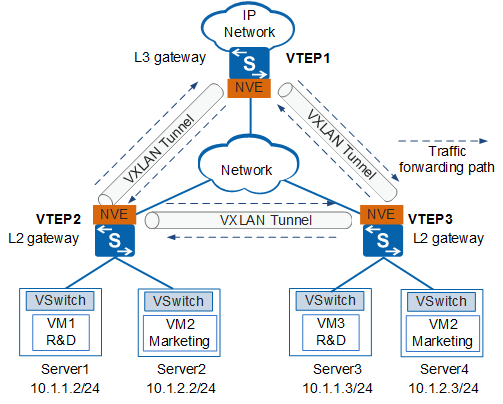Virtual Network Construction over a Campus Network
In Figure 1, an enterprise has constructed a mature campus network but does not have a dedicated data center network. All the servers of the enterprise are scattered in different departments, and they are interconnected through the campus network. The VXLAN technology can construct a virtual network over the campus network, realizing resource integration and flexible service deployment. To facilitate management and maintenance, VMs with the same service requirements are planned in the same network segment, while VMs with different service requirements are planned in different network segments. For example, VMs in the R&D department need to communicate in the same network segment; VMs in the R&D department and marketing department need to communicate across different network segments.
VXLAN enables Layer 2 communication between virtual networks. For example, in Figure 1, VTEP2 and VTEP3 are Layer 2 VXLAN gateways, and they establish a VXLAN tunnel to enable VMs in the R&D department to communicate with each other in the same network segment.
VXLAN enables Layer 3 communication between virtual networks. For example, when terminals in the R&D department want to communicate with terminals in the marketing department, VTEP1 functions as the Layer 3 VXLAN gateway to establish VXLAN tunnels with VTEP2 and VTEP3 respectively.
After static VXLAN tunnels are established between the switches, they dynamically learn flow table information, such as MAC address entries and ARP entries. After flow table information is learned, end users in the same or different network segments can communicate with each other over the VXLAN tunnels.
